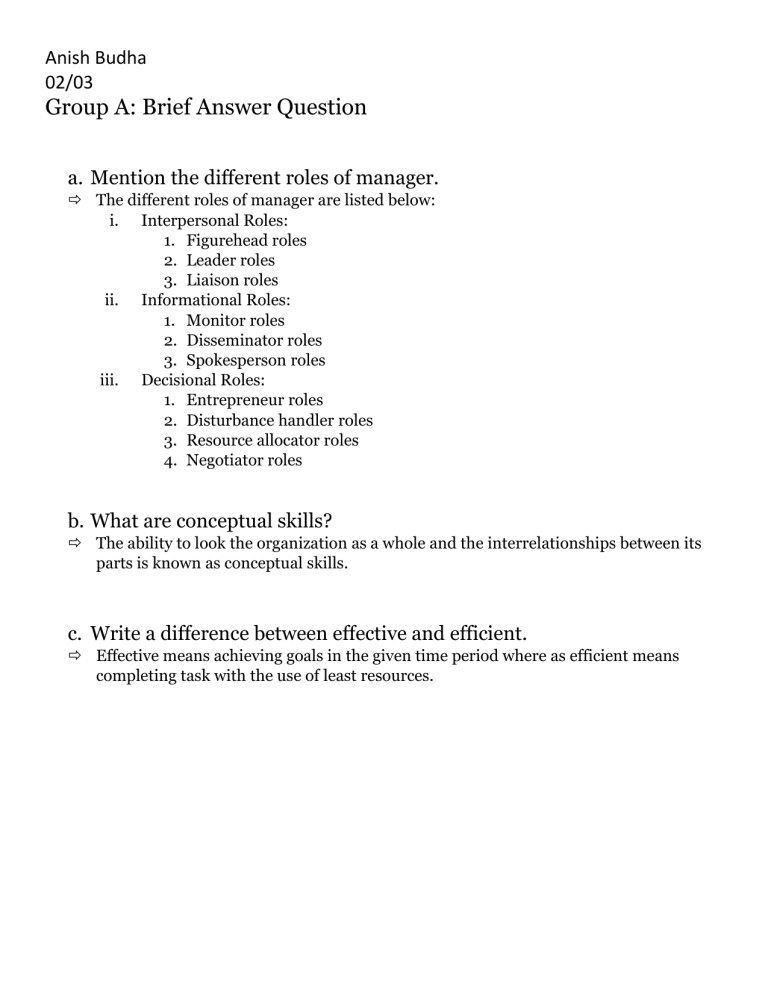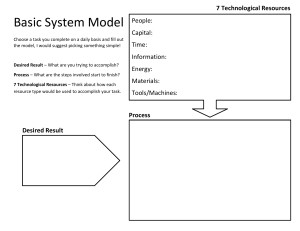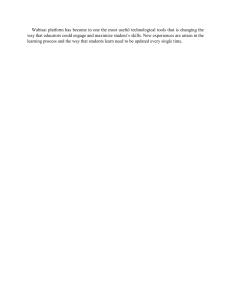
Anish Budha 02/03 Group A: Brief Answer Question a. Mention the different roles of manager. The different roles of manager are listed below: i. Interpersonal Roles: 1. Figurehead roles 2. Leader roles 3. Liaison roles ii. Informational Roles: 1. Monitor roles 2. Disseminator roles 3. Spokesperson roles iii. Decisional Roles: 1. Entrepreneur roles 2. Disturbance handler roles 3. Resource allocator roles 4. Negotiator roles b. What are conceptual skills? The ability to look the organization as a whole and the interrelationships between its parts is known as conceptual skills. c. Write a difference between effective and efficient. Effective means achieving goals in the given time period where as efficient means completing task with the use of least resources. Anish Budha 02/03 Group B: Short Answer Questions a. Who are managers? Explain briefly the emerging challenges faced by managers. A manager is a person who exercises managerial function for a part of a company or the whole business. Manager of a company allocates resources (human, financial, physical, informational) and perform the functions (planning, organizing, leading, controlling) efficiently and effectively to achieve organizational goals. Managers motivate subordinates and help them to accomplish their goals and objectives to execute plans and strategies successfully. Management is a dynamic subject. With the time and change in organization’s size and environment, new challenges are faced by managers which are discussed below: 1. Work Diversity: Work diversity may be defined as the similarities and differences between employees of an organization in terms of age, culture, gender, religion, race and sexual orientation. Diversity makes the workforce heterogeneous. It creates communication barriers among staffs. Some employees find hard to change according to their current environment. Diverse workforce may become source of conflict too. So, it’s a challenge for managers to handle employees from different origin and create a work environment for them. 2. Outsourcing: Outsourcing is an organizational practice in which company hires another company or individual to perform certain tasks, handle operations or provide services that had been done by the company itself. It helps company to focus on its core activities and reduce cost and investment. But company loses the control over the task and there are always the chances of information leaking. It also reduces the learning and innovation of organization. 3. Empowerment of employees: Employees always seek greater degree of participation in goal setting and decision-making and also demands greater avenues of selffulfillment. To respond to these demands, organizations will have to be redesigned or restructured to empower the employees so that they have sufficient autonomy or freedom to take decisions while performing their jobs. Empowerment involves giving the employees more information and control over how they perform their jobs. Empowerment would be all the more necessary to Anish Budha 02/03 speed up the process of decision-making, make use of environmental opportunities and to serve the customers and society better. 4. Technology: The technological environment consists of innovations, techniques, and the organized knowledge of the way of doing things. Modern business is characterized by newer and ever-changing technological developments. This calls for the technological perspective in management. They need to recognize and anticipate technological changes. Technological changes result in a modification in products and services; in the way, they are produced and marketed. The managers must, therefore grasp a proper understanding of these aspects of technological context. b. Who is important for an organization – customers or employees? An organization refers to a collection of people, who are involved in pursuing defined objectives. It can be understood as a social system which comprises all formal human relationships. The organization encompasses division of work among employees and alignment of tasks towards the ultimate goal of the company which is serving customers. A business needs a source of revenue to run. This is an absolute whether it is a business organization, non-for-profit organization, corporation, e-commerce or even a government organization. A business needs to have revenue to pay the bills, employees, invoices, etc. And the source of revenue are customers. In this way, we might think customers may be the first choice for an organization. But customers need to receive excellent products and services in order to open their wallets. And these exceptional services and products are provided to them by the employees. As customers have choice, they will always tend to choose what they find best for them. Happy employees tend to exhibit their enthusiasm when interacting with customers. How employees are treated, or the atmosphere of the internal culture, will dictate how your employees feel. Attitude is tied to an employee’s performance and is transformed into the quality of their work. Ultimately what is felt and experienced by customers from employees turns into a decision to return to your business or visit a competitor. Yes, there are unhappy employees at companies that generate profits, but this will always be a short-term gain. If employees are not putting their hearts into their work, service can’t help but suffer, and innovation is repressed, killing any chance for the product to evolve and satisfy the customer’s growing needs. The employees radiate and feel it, the customers experience it, and the company benefits from all of it. Group C: Long Answer Questions Anish Budha 02/03 a. Describe about the different types of managers in an organization.



